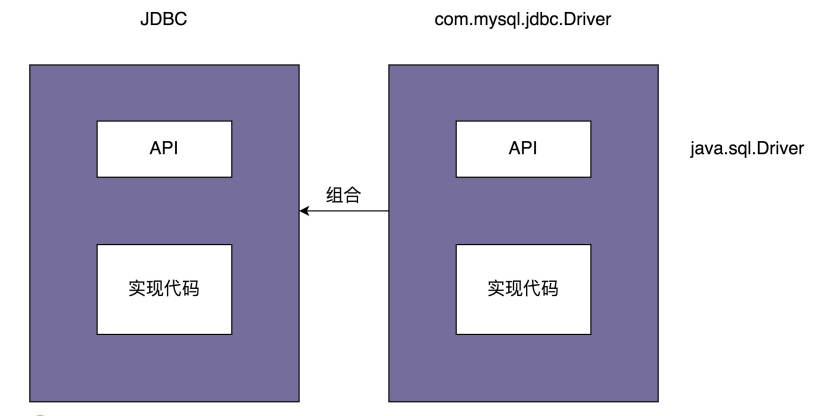今天,我们再学习另外一种结构型模式:桥接模式。桥接模式的代码实现非常简单,但是理解起来稍微有点难度,并且应用场景也比较局限,所以,相当于代理模式来说,桥接模式在实际的项目中并没有那么常用,你只需要简单了解,见到能认识就可以,并不是我们学习的重点。
桥接模式的原理解析 桥接模式,也叫作桥梁模式,英文是 Bridge Design Pattern。其中“最纯正”的理解方式,属 GoF 的《设计模式》一书中对桥接模式的定义。在 GoF 的《设计模式》一书中,桥接模式是这么定义的:“Decouple an abstraction from its implementation so that the two can vary independently。”翻译成中文就是:“将抽象和实现解耦,让它们可以独立变化。”
关于桥接模式,很多书籍、资料中,还有另外一种理解方式:“一个类存在两个(或多个) 独立变化的维度,我们通过组合的方式,让这两个(或多个)维度可以独立进行扩展。”。GoF 给出的定义非常的简短,单凭这一句话,估计没几个人能看懂是什么意思。所以,我们通过 JDBC 驱动的例子来解释一下。JDBC 驱动是桥接模式的经典应用。我们先来看一 下,如何利用 JDBC 驱动来查询数据库。具体的代码如下所示:
1 2 3 4 5 6 7 8 9 10 Class.forName("com.mysql.jdbc.Driver" ); String url = "jdbc:mysql://localhost:3306/sample_db?user=root&password=your_password Connection con = DriverManager.getConnection(url); Statement stmt = con.createStatement(); String query = " select * from test"; ResultSet rs = stmt.executeQuery(query); while(rs.next()) { rs.getString(1); rs.getInt(2); }
如果我们想要把 MySQL 数据库换成 Oracle 数据库,只需要把第一行代码中的 com.mysql.jdbc.Driver 换成 oracle.jdbc.driver.OracleDriver 就可以了。
在项目中,从一个数据库切换到另一种数据库,都只需要改动很 少的代码,或者完全不需要改动代码,那如此优雅的数据库切换是如何实现的呢?
源码之下无秘密。要弄清楚这个问题,我们先从 com.mysql.jdbc.Driver 这个类的代码看起。我摘抄了部分相关代码,放到了这里,你可以看一下。
1 2 3 4 5 6 7 8 9 10 11 12 13 14 15 16 17 18 19 package com.mysql.jdbc;import java.sql.SQLException;public class Driver extends NonRegisteringDriver implements java .sql .Driver static { try { java.sql.DriverManager.registerDriver(new Driver()); } catch (SQLException E) { throw new RuntimeException("Can't register driver!" ); } } public Driver () throws SQLException } }
结合 com.mysql.jdbc.Driver 的代码实现,我们可以发现,当执行 Class.forName(“com.mysql.jdbc.Driver”) 这条语句的时候,实际上是做了两件事情。 第一件事情是要求 JVM 查找并加载指定的 Driver 类,第二件事情是执行该类的静态代码,也就是将 MySQL Driver 注册到 DriverManager 类中。
现在,我们再来看一下,DriverManager 类是干什么用的。具体的代码如下所示。当我们把具体的 Driver 实现类(比如,com.mysql.jdbc.Driver)注册到 DriverManager 之后, 后续所有对 JDBC 接口的调用,都会委派到对具体的 Driver 实现类来执行。而 Driver 实现类都实现了相同的接口(java.sql.Driver ),这也是可以灵活切换 Driver 的原因。
1 2 3 4 5 6 7 8 9 10 11 12 13 14 15 16 17 18 19 20 21 22 23 24 25 26 27 public class DriverManager private final static CopyOnWriteArrayList<DriverInfo> registeredDrivers = new CopyOnWriteArrayList<>(); static { loadInitialDrivers(); println("JDBC DriverManager initialized" ); } public static synchronized void registerDriver (java.sql.Driver driver) throws Exception if (driver != null ) { registeredDrivers.addIfAbsent(new DriverInfo(driver)); } else { throw new NullPointerException(); } } public static Connection getConnection (String url, String user, String password) java.util.Properties info = new java.util.Properties(); if (user != null ) { info.put("user" , user); } if (password != null ) { info.put("password" , password); } return (getConnection(url, info, Reflection.getCallerClass())); } }
桥接模式的定义是“将抽象和实现解耦,让它们可以独立变化”。那弄懂定义中“抽象”和“实现”两个概念,就是理解桥接模式的关键。那在 JDBC 这个例子中,什么是“抽象”?什么是“实现”呢?实际上,JDBC 本身就相当于“抽象”。注意,这里所说的“抽象”,指的并非“抽象类”或“接口”,而是跟具体的数据库无关的、被抽象出来的一套“类库”。具体的 Driver(比如,com.mysql.jdbc.Driver)就相当于“实现”。注意,这里所说的“实现”,也并非指“接口的实现类”,而是跟具体数据库相关的一套“类库”。JDBC 和 Driver 独立开发,通过对象之间的组合关系,组装在一起。JDBC 的所有逻辑操作,最终都委托给 Driver 来执行。
我画了一张图帮助你理解,你可以结合着我刚才的讲解一块看。
桥接模式的应用举例 讲一个 API 接口监控告警的例子:根据不同的告警规则,触发不同类型的告警。告警支持多种通知渠道,包括:邮件、短信、微信、自动语音电话。通知的紧急程度有多种类型,包括:SEVERE(严重)、URGENCY(紧急)、NORMAL(普 通)、TRIVIAL(无关紧要)。不同的紧急程度对应不同的通知渠道。比如,SERVE(严 重)级别的消息会通过“自动语音电话”告知相关人员。
我们先来看最简单、最直接的一种实现方式。代码如下所示:
1 2 3 4 5 6 7 8 9 10 11 12 13 14 15 16 17 18 19 20 21 22 23 24 25 26 27 28 29 30 31 32 33 34 35 36 37 38 39 40 41 public enum NotificationEmergencyLevel { SEVERE, URGENCY, NORMAL, TRIVIAL; } public class Notification private List<String> emailAddresses; private List<String> telephones; private List<String> wechatIds; public Notification () public void setEmailAddress (List<String> emailAddress) this .emailAddresses = emailAddress; } public void setTelephones (List<String> telephones) this .telephones = telephones; } public void setWechatIds (List<String> wechatIds) this .wechatIds = wechatIds; } public void notify (NotificationEmergencyLevel level, String message) if (level.equals(NotificationEmergencyLevel.SEVERE)) { } else if (level.equals(NotificationEmergencyLevel.URGENCY)) { } else if (level.equals(NotificationEmergencyLevel.NORMAL)) { } else if (level.equals(NotificationEmergencyLevel.TRIVIAL)) { } } } public class ErrorAlertHandler extends AlertHandler public ErrorAlertHandler (AlertRule rule, Notification notification) super (rule, notification); } @Override public void check (ApiStatInfo apiStatInfo) if (apiStatInfo.getErrorCount() > rule.getMatchedRule(apiStatInfo.getApi()) { notification.notify(NotificationEmergencyLevel.SEVERE, "..." ); } } }
Notification 类的代码实现有一个最明显的问题,那就是有很多 if-else 分支逻辑。实际上,如果每个分支中的代码都不复杂,后期也没有无限膨胀的可能(增加更多 if-else 分支判断),那这样的设计问题并不大,没必要非得一定要摒弃 if-else 分支逻辑。
不过,Notification 的代码显然不符合这个条件。因为每个 if-else 分支中的代码逻辑都比较复杂,发送通知的所有逻辑都扎堆在 Notification 类中。我们知道,类的代码越多,就越难读懂,越难修改,维护的成本也就越高。很多设计模式都是试图将庞大的类拆分成更细小的类,然后再通过某种更合理的结构组装在一起。
针对 Notification 的代码,我们将不同渠道的发送逻辑剥离出来,形成独立的消息发送类 (MsgSender 相关类)。其中,Notification 类相当于抽象,MsgSender 类相当于实现,两者可以独立开发,通过组合关系(也就是桥梁)任意组合在一起。所谓任意组合的意思就是,不同紧急程度的消息和发送渠道之间的对应关系,不是在代码中固定写死的,我们可以动态地去指定(比如,通过读取配置来获取对应关系)。
按照这个设计思路,我们对代码进行重构。重构之后的代码如下所示:
1 2 3 4 5 6 7 8 9 10 11 12 13 14 15 16 17 18 19 20 21 22 23 24 25 26 27 28 29 30 31 32 33 34 35 36 37 38 39 40 41 42 43 44 45 46 47 48 public interface MsgSender void send (String message) } public class TelephoneMsgSender implements MsgSender private List<String> telephones; public TelephoneMsgSender (List<String> telephones) this .telephones = telephones; } @Override public void send (String message) } } public class EmailMsgSender implements MsgSender } public class WechatMsgSender implements MsgSender } public abstract class Notification protected MsgSender msgSender; public Notification (MsgSender msgSender) this .msgSender = msgSender; } public abstract void notify (String message) } public class SevereNotification extends Notification public SevereNotification (MsgSender msgSender) super (msgSender); } @Override public void notify (String message) msgSender.send(message); } } public class UrgencyNotification extends Notification } public class NormalNotification extends Notification } public class TrivialNotification extends Notification } Notification notification = new SevereNotification(new TelephoneMsgSender()); notification.notify("xxx" );
